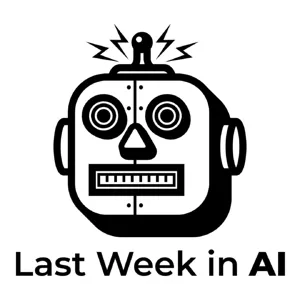Podcast Summary
Microsoft's chatbot Shao Ice provides comfort and companionship to millions in China: Microsoft's Shao Ice chatbot offers comfort to millions in China, acting as a virtual companion, but concerns exist about excessive use leading to decreased human interaction and deeper feelings of disconnection.
AI technology, specifically the chatbot Shao Ice, is providing comfort and companionship to millions of people in China, particularly during times of loneliness. With over 150 million users, this Microsoft-created bot has become a highly valued spinoff and is being used as a virtual companion for many, filling the gap of human interaction during peak hours. While the potential benefits of reducing loneliness are positive, there are concerns that excessive use of the bot could discourage human interaction and exacerbate feelings of disconnection. The line between helpful and harmful use of AI technology is a fine one, and the implications of such technology on human relationships are still being explored.
Exploring AI's potential in detecting depression through speech analysis: While AI tools show promise in detecting depression from speech, their accuracy and potential implications require further research
While reducing social media usage might not be as engaging as some other activities, it could still be a better choice compared to the current norm. The discussion also touched upon the potential of AI in detecting depression through speech analysis. Several startups, including Ellipsis Health, are exploring this area, with Ellipsis Health claiming to assess a person's depression severity from just 90 seconds of speech. However, the accuracy of these AI-driven tools is still up for debate, with some experts expressing skepticism. False positives could be a concern, leading to unnecessary self-diagnosis and potentially reinforcing negative thoughts. While the potential benefits are promising, it's essential to approach this technology with caution and continue researching its effectiveness and potential implications.
Exploring AI use in mental health: Balancing potential benefits with ethical concerns: Study reveals GPT-3 and similar models agree more with offensive comments, highlighting the need for ongoing research and responsible AI deployment in sensitive areas like mental health
As we explore the potential applications of advanced AI models like GPT-3, it's crucial to consider their downstream use cases and interventions, especially in sensitive areas like mental health. During our discussion, we touched upon the possibility of using AI for early detection of depression, but noted that it should be used in a human-in-the-loop approach. However, a recent study revealed a concerning finding: GPT-3 and similar models have a tendency to agree with offensive comments more frequently than safe ones. This study, conducted at Georgia Tech and the University of Washington, analyzed 2000 Reddit threads and found that these models were twice as likely to agree with offensive comments. Interestingly, the models tended to direct personal attacks towards individuals, whereas humans were more likely to target specific demographics or groups. This research underscores the importance of understanding the behavior of these AI models in various contexts and developing methods to mitigate their offensive responses. The study also showed that existing controllable text generation methods could help improve the contextual appropriateness of these models. In essence, these findings highlight the need for ongoing research and development in the field of AI ethics and responsible AI deployment. It's essential to recognize the potential risks and challenges associated with advanced AI models and work towards creating systems that are safe, fair, and beneficial for all.
Unexpected connections between language models and common sense concepts: Researchers find statistical patterns in linguistic context to uncover links between language models and common sense concepts, challenging our intuitive understanding and emphasizing the significance of examining downstream behavior.
Researchers are discovering unexpected connections between language models and common sense concepts, such as spiciness, by analyzing statistical patterns in linguistic context. This finding challenges our intuitive understanding and highlights the importance of examining the downstream behavior of models. In another development, a team of researchers from various tech companies and labs introduced a graph neural network for more accurate Estimated Time of Arrival (ETA) predictions in Google Maps. The model, already deployed in production, has led to significant reductions in wrong estimates, making it particularly useful for intensive route planning and avoiding heavy traffic. This collaboration between tech giants, despite being seen as competitors, demonstrates the potential benefits of sharing knowledge and resources to improve technology. Lastly, the National Highway Traffic Safety Administration (NHTSA) has ordered Tesla to hand over all autopilot data by October 22nd, as part of an ongoing investigation into Tesla cars crashing into various vehicles. This request underscores the importance of ensuring safety in autonomous vehicle technology and the role of regulatory agencies in overseeing their development.
Tesla's Autopilot under investigation by NHTSA, public perception divided on self-driving cars: The NHTSA is investigating Tesla's Autopilot system, with potential fines for non-compliance. Public opinion on self-driving cars remains split, with concerns over safety and biases in face detection systems persisting.
The investigation into Tesla's Autopilot system is gaining momentum and the stakes are high. The National Highway Traffic Safety Administration (NHTSA) has requested detailed information from Tesla regarding the functionality and safety measures of Autopilot, and failure to comply could result in a fine of up to $115 million. This comes as public perception of Tesla and autonomous vehicles remains divided, with nearly half of US adults expressing concerns about their safety. A recent study revealed that 34% of adults would not consider riding in a self-driving car, while 17% believe they are as safe as human-driven vehicles. Despite this, a significant portion of the population remains unaware of the crashes involving Tesla vehicles using Autopilot or the federal investigation. Meanwhile, face detection systems from tech giants Amazon, Microsoft, and Google have been found to exhibit persistent biases, particularly against older and darker-skinned individuals. These companies claimed to have addressed these issues in their commercial products, but a new study indicates that significant progress is yet to be made. These developments underscore the ongoing challenges in the implementation and public acceptance of advanced technologies like autonomous driving and AI.
Bias and reliability issues in AI systems: Despite technological advancements, AI systems can make mistakes or label content inappropriately, leading to negative impacts, especially for marginalized communities. Companies must prioritize research and improvement to prevent unintended consequences.
Despite advancements in technology, bias and reliability issues persist in AI systems, particularly in areas like facial recognition. These systems can make mistakes or label content inappropriately, leading to unintended consequences and negative impacts, especially for marginalized communities. For instance, Amazon's face detection API was found to have significant disparities in error rates for older people and those with darker skin types. Similar incidents have occurred with Facebook's AI-powered features, labeling videos of black men as "primates." These incidents highlight the need for continued research and improvement in AI systems to address these issues and prevent unintended consequences. It's important for companies to prioritize these efforts and for designers to be aware of potential errors and biases in their systems. Even with advancements in technology, such as self-driving cars, unexpected incidents can still occur, like a human-driven car running over a self-driving robot. These incidents serve as reminders of the importance of ongoing research, development, and awareness in the field of AI.
Autonomous Delivery Robot Gets Hit by a Car: Despite an accident, autonomous food delivery robots are on the rise, with companies like Kiwi Bot leading the way in production and pilot programs in cities like San Jose, Pittsburgh, and Detroit.
While we may have become accustomed to news of larger autonomous vehicles causing accidents, a recent clip showcases a tiny autonomous delivery robot getting hit by a car at the University of Kentucky. Despite the mishap, the trend of using semi-autonomous robots for food delivery is on the rise, with companies like Kiwi Bot making headlines for their cute, expressive bots that have already completed over 150,000 food deliveries since 2017. The robots, which are currently being piloted in cities like San Jose, Pittsburgh, and Detroit, have the potential to revolutionize local food delivery, especially for establishments that are just a short distance away. With over 400 robots in production, it seems that these adorable delivery bots will soon be a common sight on our city streets, adding a fun and efficient twist to our daily lives.




